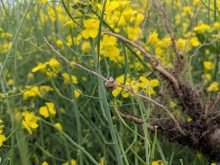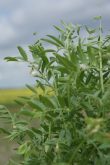The disease has caused economic yield losses in a small number of fields, but its presence could become a lingering issue for cereal growers
Bacterial leaf streak is not going away.
The disease was present this summer in possibly “hundreds” of irrigated fields of barley, durum and spring wheat in southern Alberta, said Mike Harding, a plant pathologist with Alberta Agriculture.
The disease caused economic yield losses in a small number of fields, but its presence could become a lingering issue for cereal crop production.
“This disease is not going away…. It’s hanging around,” Harding said in mid-October.
Read Also

Huge Black Sea flax crop to provide stiff competition
Russia and Kazakhstan harvested huge flax crops and will be providing stiff competition in China and the EU.
“We mostly found it on durum wheat and barley…. I saw it on more barley fields this year than I did last year.”
Bacterial leaf streak is caused by a group of bacteria called Xanthomonas translucens. A few different pathovars, or strains within the group, can cause damage on cereal crops such as spring wheat, barley and durum.
The bacterium can persist on crop residue, or, more likely, it arrives in the field on cereal seed contaminated with the disease. Wind and rain also move the bacteria from plant to plant.
The defining symptom of bacterial leaf streak is dark green, water-soaked streaks on the leaf. Plant pathologists sometimes describe it as a shiny glaze of bacteria on the leaf.
“If the crop is dry (and) you take that leaf tissue and you angle it in the sun, you may see masses of the bacterial cells on the leaf surface,” Kelly Turkington, a plant pathologist with Agriculture Canada in Lacombe, Alta., said in 2021.
“It gives the leaf a bit of a glazed doughnut appearance…. You’ll see a shellac or coating on the lesions.”
When the lesions grow on the leaves, it reduces photosynthesis and robs the wheat crop of yield.
Harding doesn’t have precise data on the number of fields with bacterial leaf streak symptoms in 2023, but it’s definitely an issue in southern Alberta on irrigated land. Testing confirmed its presence on at least 20 fields, but the actual number is much higher.
“We heard, through the grapevine, it was probably present in hundreds of fields … probably at economic levels in a handful (of fields),” said Harding, who is based in Brooks, Alta.
“There were a couple of fields I visited (where) every plant had symptoms and it was fairly severe.”
There were a few sightings of the disease in other parts of Alberta, but not at economic levels, Harding added.
The challenge with bacterial leaf streak is it’s a bacteria, not a fungus.
The crop protection industry has developed tools to deal with fungal infections, but they don’t exist for a bacterial infection.
The good news is that commercial seed labs can test wheat, barley and durum for bacterial leaf streak before planting next year’s crop.
“Producers can take grain or seed samples in and have them tested for the presence of bacterial leaf streak,” Harding said.
“All we can do is try to start as clean as we can by using crop rotation and getting the best quality seed we can get.”
However, there are no guarantees that seed testing will resolve the issue. The bacteria could be present on grassy weeds or volunteer plants, or it could blow into a field during a rainstorm.
Plant pathologists are always worried about disease, but because bacterial leaf streak was a problem in 2023, which was dry, what will happen in a wet growing season, Harding asked.
“If and when the year comes that we get some moisture in July, this is still something that could (pose) some real problems that we’re not really well-equipped to handle.”


















